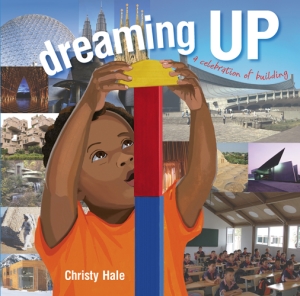2018 School Spending Survey Report

Find more great Horn Book content at these links:
Recommended books: reviews and themed booklists
App and e-book reviews
Movie reviews
Event news and recaps
Events calendar
Five questions for Christy Hale
In her 2013 Boston Globe–Horn Book Nonfiction Honor book Dreaming Up: A Celebration of Building (Lee & Low, 2012), Christy Hale juxtaposes concrete poems and illustrations of children at building play with photographs of innovative architecture around the world.

In her 2013 Boston Globe–Horn Book Nonfiction Honor book Dreaming Up: A Celebration of Building (Lee & Low, 2012), Christy Hale juxtaposes concrete poems and illustrations of children at building play with photographs of innovative architecture around the world. We asked her about the tipping point for this ingenious idea, her love of poetry, and more.
Ms. Hale will be accepting her Boston Globe–Horn Book Nonfiction Honor at the ceremony on Friday, October 4th, and speaking at the Horn Book at Simmons Colloquium on Saturday, October 5th. Register for Horn Book at Simmons now to see her at both events!
1. Dreaming Up draws a fascinating comparison between children’s play and architectural structures. What first inspired this idea?
Christy Hale: The idea incubated for years as I kept seeing connections between the two. In the summer of 1993, I studied painting in Barcelona and visited many of Antoni Gaudí’s structures. La Sagrada Família, with its fluid, playful turrets was unlike anything I’d ever seen — except maybe sand castles.
I studied at Pratt Institute and lived in Brooklyn for eighteen years. I often went into Manhattan to the museums on Fifth Avenue. After my daughter, Kate, began playing with stacking rings, I looked at the Guggenheim museum in a new way. When Kate began wooden block play, I recalled seeing slides of Fallingwater in art history class and learning that Frank Lloyd Wright played with Froebel blocks as a child.
I was struck by the idea that children in their play employ exactly the same kind of design and engineering thinking as architects. I began a list of ways that children build, then hunted for modern structures around the world that were related visually.
2. Which came first: the illustrations, the poems, or the structures to highlight?
CH: The structures were my starting point. I hunted through many photographs to find just the right view. After I finished with the photo research I began the illustrations. I wanted there to be a strong visual connection between each illustration and the corresponding architect’s creation.
Several poems were written early in the process, some much later. There was back-and-forth with the three different elements, making adjustments to find a balance, so illustrations didn’t steal attention from the photos and so concrete poems (another type of illustration) would also fit in the mix.
 3. Your background is fine art and design. What led you to experiment with poetry?
3. Your background is fine art and design. What led you to experiment with poetry?CH: As a big sister, I used to “read” poetry to my younger brothers every night. Squeaky clean from their baths, they lay against the pillows calling out the last word of each rhyming line. We knew countless poems by heart — the rhythms part of us in deep, comforting ways. I can still recite those poems. Poetry sticks.
I wrote lots of lame poems in my teens, though in high school I did win an honorable mention in a California state poetry contest.
At Lewis & Clark College (before Pratt), my roommate was Barbara Stafford, daughter of the late William Stafford (Poet Laureate of Oregon and Poet to the Library of Congress, 1970). I became close friends with the family. Kim Stafford, Barbara’s brother, introduced me to letterpress printing. I began creating chapbooks with poets, hand-setting every tiny letter, cutting woodblocks, printing, and binding my own editions. In 1990 I designed and created linoleum cuts for a William Stafford chapbook, How to Hold Your Hands When It Rains. I gravitate to poets and I continue working away on my own poetry.
I showed my editor a couple of concrete poems when I pitched Dreaming Up. She encouraged me to approach the whole book this way. The poems are for the very young, much like those I read to my younger brothers years ago.
4. Do you also have experience in architecture?
CH: I took a modern architecture art history class in graduate school and I studied design at Pratt. I notice and appreciate architecture, but I am not trained to design buildings.
5. How many of the places in the book have you visited?
CH: Sadly, I have only visited two places, La Sagrada Família, and the New York Guggenheim. I gained familiarity with Zaha Hadid’s work at a 2006 Guggenheim exhibit featuring the architect. My daughter recently started in the design school at Carnegie Mellon, not far from Fallingwater, so I hope to visit there. For the other sites, I keep dreaming up.
RECOMMENDED
ALREADY A SUBSCRIBER? LOG IN
We are currently offering this content for free. Sign up now to activate your personal profile, where you can save articles for future viewing.







Add Comment :-
Be the first reader to comment.
Comment Policy:
Comment should not be empty !!!